Astronomy Midterm
1/102
There's no tags or description
Looks like no tags are added yet.
Name | Mastery | Learn | Test | Matching | Spaced |
|---|
No study sessions yet.
103 Terms
Waxing Moon
The phase of the Moon after the new Moon and before the full Moon when the lit portion appears to grow larger.
Waning Moon
The phase of the Moon after the full Moon and before the new Moon when the lit portion appears to decrease.
Revolution of the Moon
The motion of the Moon around the Earth.
Rotation of the Moon
The spinning of the Moon about its own axis.
First Quarter
A phase of the Moon where half of the Moon is lit, appearing to observers on Earth as the right side lit.
Third Quarter
A phase of the Moon that follows the full Moon where half of the Moon is lit on the left side as seen from Earth.
Solar Eclipse
An event that occurs when the Moon covers the Sun, either totally or partially, usually during the New Moon phase.
Lunar Eclipse
An event where the Earth's shadow falls on the Moon, either totally or partially, typically during the Full Moon phase.
Eclipses
Astronomical events involving the shadow of one celestial body falling on another; includes both solar and lunar eclipses.
Full Moon
The phase of the Moon when it is fully illuminated as seen from Earth.
Astronomy
scientific study of the planets, stars, galaxies, the universe as a whole
Astronomical Unit (AU)
Average distance from Earth to the Sun. Approximately 150 million kilometers
Massive
Contains mass
Scientific Method
The formal procedure used to test (attempt to falsify) the validity of a scientific hypothesis and theories
Theory
A well developed (group of) ideas tied solidly to known physical laws and make testable predictions about the universe.
Idea
An untested notion about how something might be
Fact
An observation or measurement
Hypothesis
An idea that leads to testable predictions
Law
Series of observations that scientists that can use to make predictions with no explanation of why it occurs
Scientific Principle
A generalization about the universe that guides scientists in the construction of a new hypothesis; not independent of other principles
Light Time Travel
How long it would take for light to travel a given distance. Used do to it being the fastest possible speed, always the same speed, 300,000 kilometers/second
Light Year
The distance that light travels in one year, approximately 9.46 trillion kilometers. It is used to measure astronomical distances.
Big Bang
The leading explanation for the origin of the universe 13.8 billion years ago, suggesting it began as an extremely hot and dense point and has been expanding ever since.
In the beginning only Helium and Hydrogen existed with traces of Lithium, Beryllium, and Boron. These combined to make stars and galaxies, leading to the formation of heavier elements through nuclear fusion in stars.
Satellite
Object in orbit more massive than a body
Nuclear Diffusion (stars)
that emit light and heat due to nuclear fusion in their cores, serving as the building blocks of galaxies.
Nuclear Fusion (stars)
is the process where two light atomic nuclei combine to form a heavier nucleus, releasing energy in the process. It is the reaction that powers stars and produces heavier elements.
Cosmic Location
Universe ,Laniakea Supercluster, Virgo Supercluster, Local Group, Milky Way, Solar System, Earth
Waves
Radio, Microwave, Infared, Visible, Ultra Violet, X-ray, Gamma Ray
Falsified
The ability to be proven wrong
Occam’s Razor
When faced with competition hypothesis that explain all observations equally well, choose the one with the fewest assumptions, the simpler explanation
Cosmological Principle
The testable assumption that the same physical laws that apply here and now also apply everywhere and at all times; there is no special locations or directions in the universe
Zenith
Point directly above the observer in the celestial sphere
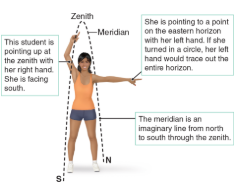
Meridian
The line on the celestial sphere that runs from north to south dividing the sky into an eastern half and a western half
Horizon
The line that separates the sky from the ground. Perpendicular to zenith then spin 360 that’s your horizon

Celestial Sphere
Imaginary sphere with celestial objects in its inner surface.
Initially created by the Ancient Greeks
Constellation
Group of stars that seem fixed pattern on the celestial sphere
Day
Time it takes Earth to rotate on its axis.
A sidereal day is the time it takes for the Earth to complete one full rotation relative to distant stars, approximately 23 hours and 56 minutes.
A solar day, which is about 24 hours, measures the time from one noon to the next, accounting for Earth's orbit around the Sun.
Apparent Daily Motion
The daily path each object takes across the sky.
Altitude
The location of an object above the horizon or the angle formed between the object and the observer's line of sight, measured in degrees.
Latitude
The angular distance north or south from the equatorial plane of a nearly spherical body
Longitude
The angular distance west or east from the equatorial plane of a nearly spherical body
Circumpolar
Can always be seen from the horizon from a specific location on Earth, appearing to circle around the celestial pole.
Revolve
One object orbits another
Rotate
Spin on an axis
Ecliptic
The annual path of the sun against the stars; this follows the zodiac the 12 constellationsand is the basis for the changing seasons and the positions of celestial objects in the sky.
Summer Solstice
When the north pole is titled towards the sun, the day when the sun is the highest in the sky as it crosses the meridian, the sun rises farthest north of east, sets furthest north of west, marks the first day of summer typically on June 21
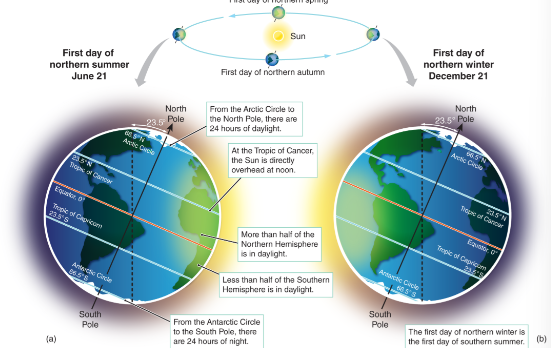
Winter Solstice
When the north pole is tilted away from the sun, resulting in the shortest day of the year, typically occurring around December 21.

Equinoxes
Twice a year when day and night are of approximately equal length, marking the beginning of spring and fall, typically occurring around March 21 and September 23.
Tropical Year
The time between equinoxes which is slightly shorter than 1 solar Earth orbit and is approximately 365.24 days long, marking the cycle of seasons.
Tropics
the regions of Earth located between the Tropic of Cancer and the Tropic of Capricorn (23.5 N and 23.5 S), the sun is directly overheard on the equinoxes
Precession of the Equinoxes
The change of the positon of the equinoxes over time due to the Earth's axial tilt and orbital motion, resulting in a gradual shift in the alignment of the stars as viewed from Earth.
Noon
The time at which the Sun crosses the meridian.

Equator
Imaginary line on Earth dividing it in half.
At the equator all stars rise and set each day.
At other latitudes, the celestial equator intersects the horizon due east and due west. Therefore, a star on the celestial equator rises due east and sets due west. Stars north of the celestial equator rise north of east and set north of west. Stars south of the celestial equator rise south of east and set south of west.
Tropical Year
The time between one crossing ot the vernal equinox and the next. Slightly shorter than the time it takes for Earth to orbit once about the sun.
New Moon
When the moon is between Earth and the sun.
Far side illuminated, from Earth its in darkness.
-UP AT DAYTIME.
Up at daytime
NEVER visible in night
Rises with the sun at sunrise
Crosses the meridian near noon
Sets with the sun in the west.
Cresent
Phase in which the object appears less than half illuminated by the Sun
Gibbous
Phase in which the object appears more than half illuminated by the Sun

Waxing Crescent
Moon visible east of the sun
Most noticeable just after sunset, near the west
Lit on the west side
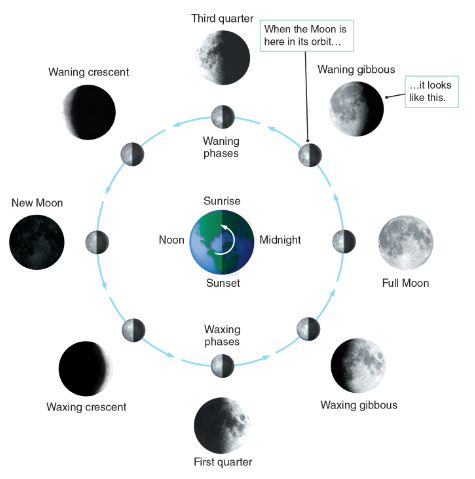
First Quarter Moon
1 week after a new moon
Named due to a fourth of its way through orbit
Rises at noon
Meridian at Sunset
Sets as Midnight
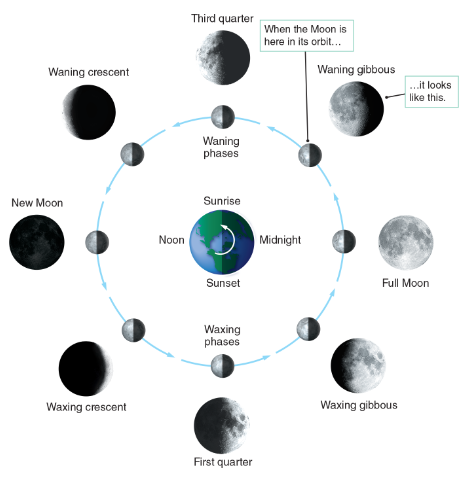
Full Moon
Opposite of the sun
Viewed from Earth fully illuminated by the sun
2 weeks after the new moon
Rises as the sun sets
Meridian at midnight
Sets at sunrises

Third Quarter Moon
Half of the near side is in sunlight and half darkness
Rises at Midnight
Crosses meridian near sunrise
Sets at noon
Eclipse
When the shadow of one astronomical object falls on another

Solar eclipse
When the Moon passes between Earth and the Sun casts a shadow on Earth.
small shadow
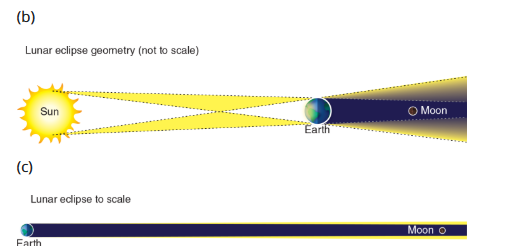
Lunar Eclipse
Moon is in the Earth’s shadow occurs when the Earth passes between the Sun and the Moon, causing the Earth’s shadow to cover the Moon.
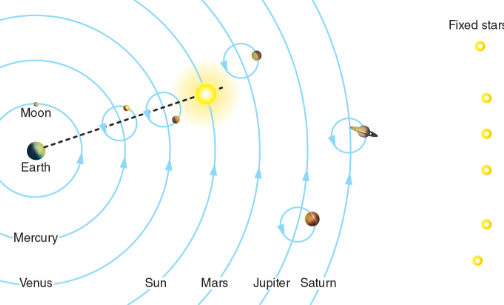
Geocentric Model
An Earth-centered model of the solar system which prevailed for 1,500 years in which the planets and the sun moved in circles around a stationary Earth
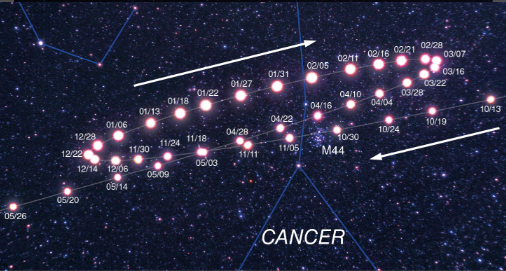
Apparent Retrograde Motion
Movement of the planets with respect to the “fixed stars” in which plants appear to move westward for a period of time before resuming their regular eastward motion. The explanation of this is much simpler with the heliocentric model compared to the geocentric.
This can be easily understood as an illusion caused by the relative motion between Earth and the other planets
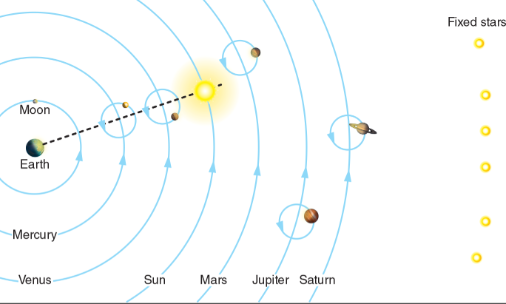
Ptolemy’s Explanation of Apparent Retrograde in the Geocentric Model
Ptolemy’s model of the solar system included interconnected circles. While traveling along its large circle, a planet would at the same time be moving along its smaller circles.
Heliocentric Model / Copernican Revolution
While not the first person to propose that the solar system was centered on the sun, Copernicus (1473-1543) was the first to develop a mathematical model that made testable predictions about the planetary orbits published in De revolutionibus orbium coelestium (“On the Revolutions of the Heavenly Spheres”)
A frame of reference
A coordinate system within which an observer measures positions and motions.
Empirical
Based on observation and experimentation rather than theory or pure logic.
Kepler’s Three Laws
Law of Planetary Motion Planets move in elliptical orbits
Law of Equal Areas Planets move fastest when its closest to the Sun and slowest when it is further from the sun / the area swept out by a planet during a specific time interval is always the same regardless of the location of the planet in orbit
Harmonic Law The mathematical relationship between the period of a planets orbit (in years) and its semimajor axis (AU) Distance³ = p²
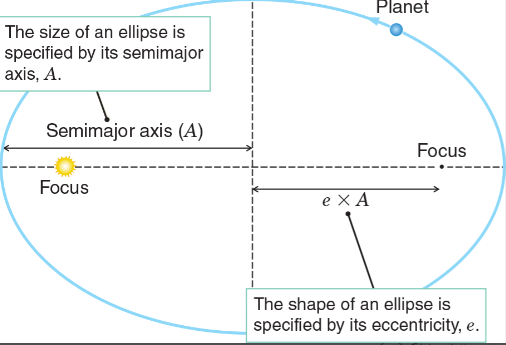
Ellipse
A specific type of oval symmetric from right to left and from top to bottom. The semi major axis defines the size of an ellipse.
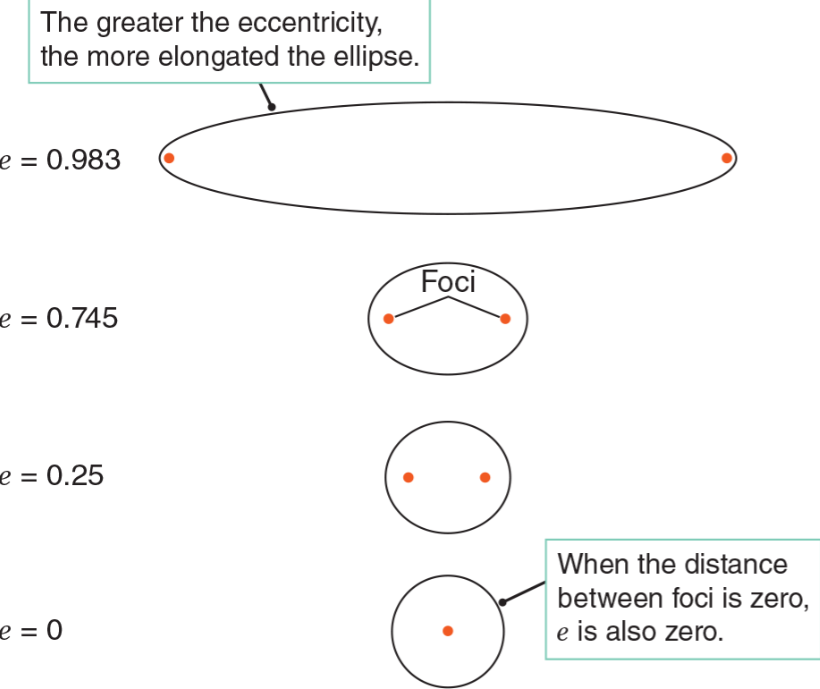
Foci
One of two points that define an ellipse
The shape of an ellipse is given by is eccentricity (e) the ratio of the distnace between foci to the length of the major axis ranging from 0-1. A numeral closer to 0 indicating a shape more comparable to a perfect circle.
Newton’s Law of Motion
First Law (Law of Inertia): An object at rest stays at rest, and an object in motion continues in motion with the same speed and in the same direction unless acted upon by a net external force.
Second Law (Law of Acceleration): The acceleration of an object is directly proportional to the net force acting on it and inversely proportional to its mass. This is often expressed with the formula F = m*a, where F is the force, m is the mass, and a is the acceleration.
Third Law (Action and Reaction): For every action, there is an equal and opposite reaction. This means that for every force exerted by one object on another, there is a force of equal magnitude but in the opposite direction exerted by the second object on the first.
Velocity
speed with direction
acceleration
rate of change of velocity
Ole Rømer
Studied movement of Jupiter moons observing that they did not follow the predicted schedule set up Kepler’s Laws due to the Earth’s orbit
Light
Properties of Light
Light moves @ 300,000 km/s Romer
Measured by observing Juptiter’s moon Io
Io period 1769
Light is a form of energy
Force relation to energy
Motion of object require energy
Energy is the ability to do work on matter; doing work involves changing the speed of objects (kinetic energy)
Doing work involves changing the speed of objects
Law of conservation of energy
Energy can be converted from one to another but it cannot be created or destroyed
Joules (J) standard measurement
KE = ½ mv^2
V = speed
M = mass
Power
Energy = / = power
Power is the rate at which you use energy or do work
Power energy/time
Waves
Means of transporting energy
Typically requires a medium
Mechanical Waves
Wave that periodically deforms then regains its shape
Electromagnetic waves
Can travel through a vacuum/without a medium
Peaks / crests
Highest points on the wave
Valleys / troughs
lowest point on the wave
Wavelength
length between crests
Period
The time it takes for one wave to pass by a given point in the medium or one point in space
Frequency
Record of how many full wave cycles pass by a given point in space per second
Kinetic Energy
Energy due to its motions and mass.
Thermal Energy
Sum of kinetic energy of the moving bits of matter inside a substance
Potential Energy
Energy stored in an object due to its position or configuration.
Light as a Wave
Requires a mediumto travel through, such as air or water, and exhibits properties like reflection, refraction, and diffraction.
Light as a Particle
Describes light's behavior as discrete packets of energy called photons, which can transfer energy, exhibit particle-like properties, and account for phenomena like the photoelectric effect.
electromagnetic wave
A type of wave that consists of oscillating electric and magnetic fields and can travel through a vacuum, carrying energy across space.

Electromagnetic Spectrum
Gamma, X-ray, UV, Visible, Infared, Microwave, Radio Waves (LEFT TO RIGHT wavelength increasing therefore decreasing the energy)
Matter
Anything that occupies space and has mass
Absorption
The capture of electromagnetic radiation by matter
Emission
The release of electromagnetic radiation by matter
Integration Time
The time interval during which the eye can add up photons—this is analogous to leaving the shutter open on a camera. The brain “reads out” the information gathered by the eye about every 100 milliseconds (ms).
Quantum efficiency
A measure of the detector's efficiency in converting incoming photons into detectable signal. It represents the percentage of photons hitting the detector's surface that successfully produce an electron-hole pair, which contributes to the measured signal. Higher quantum efficiency indicates better sensitivity, as more of the incoming light is converted into a usable signal.